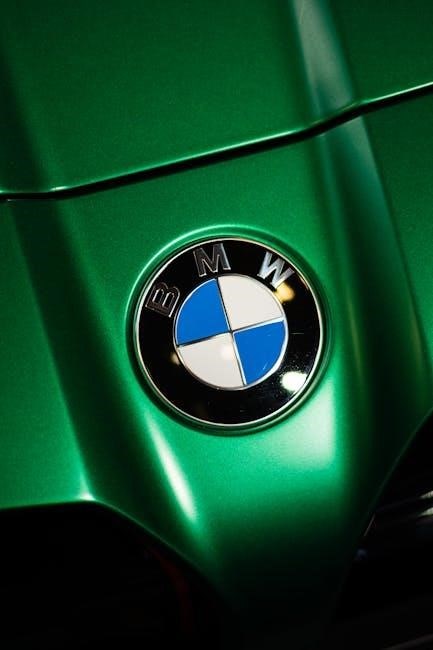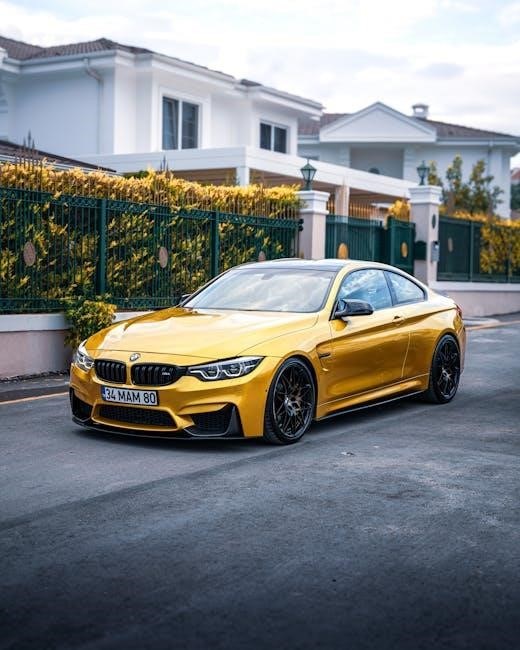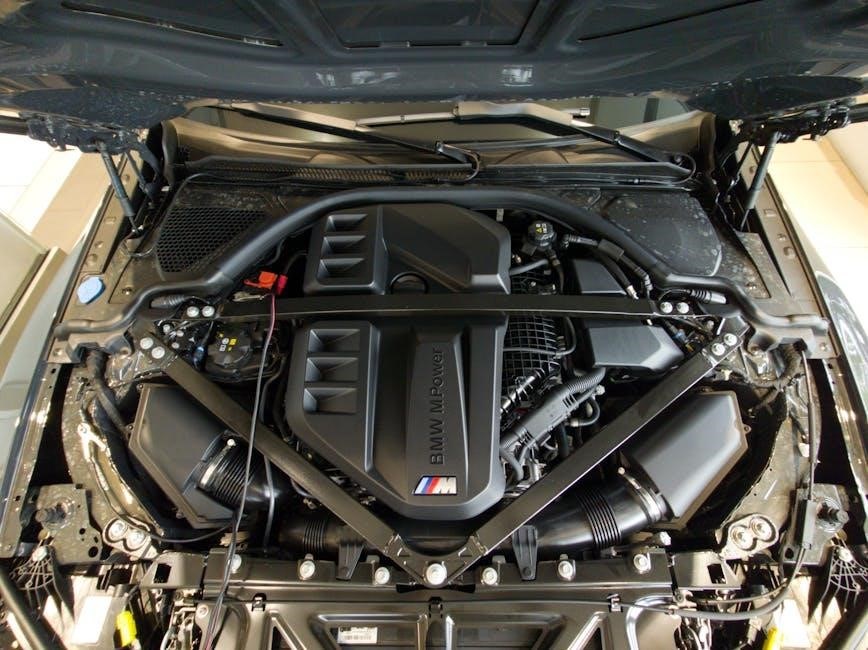Welcome to the BMW X5 Buyer’s Guide, your comprehensive resource for navigating the purchase and ownership of this luxurious SUV․ Discover key insights, model comparisons, and expert tips to make an informed decision․
Overview of the BMW X5
The BMW X5 is a luxury SUV that combines powerful performance, sleek design, and advanced technology․ First introduced in 1999, it has become a cornerstone of BMW’s lineup, blending sporty dynamics with practicality․ Known for its refined driving experience, the X5 appeals to both enthusiasts and families․ Its robust build quality and premium interiors make it a top choice in its class․ Over the years, the X5 has evolved to include various engine options, including gasoline, diesel, and hybrid variants, catering to diverse preferences and needs․
With a focus on innovation, the X5 incorporates cutting-edge features like advanced infotainment systems, adaptive suspension, and a range of driver-assistance technologies․ Whether for daily commutes or off-road adventures, the X5 delivers versatility and reliability, making it a popular choice among luxury SUV buyers․ Its reputation for longevity and strong resale value further enhances its appeal․ As a result, the BMW X5 remains a standout option for those seeking a balance of luxury, performance, and practicality․
Importance of Research for Potential Buyers
Research is crucial for potential BMW X5 buyers to ensure informed decisions․ Understanding the various model generations, engine options, and maintenance costs can prevent costly surprises․ Investigating reliability, fuel efficiency, and resale value helps narrow down choices․ Comparing trim levels and packages ensures the selected vehicle meets lifestyle needs․ Additionally, reviewing common issues in older models and understanding the benefits of new versus used purchases is essential․ Engaging with forums and owner communities provides real-world insights․ Prioritizing test drives and inspections ensures compatibility and satisfaction․ Thorough research empowers buyers to make smarter choices, balancing performance, practicality, and budget for long-term ownership satisfaction․

BMW X5 Model Generations
Explore the evolution of the BMW X5 through its four distinct generations, from the E53 (1999–2006) to the G05 (2018–Present), each offering unique features and advancements․
E53 (1999–2006): The First Generation
The BMW X5 E53, introduced in 1999, marked BMW’s entry into the SUV market, blending luxury with off-road capability․ It featured a robust design, optional all-wheel drive, and a range of engines, including inline-6 and V8 options․ Known for its on-road performance and premium interior, the E53 established the X5 as a pioneer in the luxury SUV segment․ Early models were praised for their handling and build quality, though reliability issues and higher maintenance costs were noted as the vehicles aged․ Buyers should prioritize well-maintained examples and budget for potential repairs․ The E53 remains a sought-after choice for enthusiasts of classic BMW design and driving dynamics, offering a unique blend of heritage and functionality․
E70 (2006–2013): The Second Generation
The E70 generation, produced from 2006 to 2013, marked significant improvements for the BMW X5․ It featured a more refined design, enhanced interior space, and advanced technology compared to its predecessor․ This generation introduced a wider range of engine options, including gasoline and diesel variants, catering to diverse buyer preferences․ The E70 also saw the integration of BMW’s iDrive system, offering improved infotainment and connectivity․ While overall reliability is solid, some owners have reported issues with the electronic systems and higher maintenance costs over time․ Proper research and regular maintenance are key to owning an E70 X5․ Its blend of performance, luxury, and practicality makes it a popular choice among SUV enthusiasts․
F15 (2013–2018): The Third Generation
The BMW X5 F15, produced from 2013 to 2018, marked a significant evolution in design and technology․ It featured a more refined exterior with updated LED headlights and a modernized interior․ Engine options included efficient gasoline and diesel choices, with the xDrive50i offering robust performance․ The F15 introduced improved infotainment systems and enhanced connectivity, along with practicality improvements like increased cargo space․ Safety was a priority, with advanced driver-assistance systems․ While generally reliable, some owners reported issues with engine components and electronics․ As a used model, the F15 retains strong value, combining luxury with capability, making it a sought-after choice for SUV enthusiasts․
G05 (2018–Present): The Fourth Generation
The G05 generation, introduced in 2018, marks the latest evolution of the BMW X5, offering refined design, advanced technology, and improved performance․ It features a bold front grille, slimmer LED headlights, and a more spacious interior․ The iDrive infotainment system was updated to a 12․3-inch touchscreen, enhancing connectivity and usability․ Engine options include powerful petrol and diesel variants, as well as a plug-in hybrid model for eco-conscious buyers․ The X5 M Performance variant delivers exceptional power for enthusiasts․ With its balance of luxury, capability, and innovation, the G05 continues to solidify the X5’s reputation as a premium SUV․ It remains a top choice for those seeking a blend of style, comfort, and driving dynamics․

Engine and Performance Options
The BMW X5 offers a range of powerful engines, including gasoline, diesel, hybrid, and high-performance M variants․ Each option balances power, efficiency, and driving dynamics to suit diverse preferences and needs․
Gasoline Engines: Features and Reliability
The BMW X5 offers a range of powerful and refined gasoline engines, known for their smooth performance and responsive acceleration․ Popular options include the 3․0L inline-6 and 4․4L V8, delivering exceptional power for both daily driving and adventurous scenarios․ These engines are paired with advanced technologies like turbocharging and direct injection, ensuring efficiency without compromising on performance․ Reliability is a strong suit, with many owners reporting low mechanical issues when properly maintained․ However, higher maintenance costs compared to diesel variants and slightly lower fuel economy are considerations․ For drivers prioritizing sheer power and a dynamic driving experience, the gasoline engines in the X5 are a compelling choice․
Diesel Engines: Benefits and Considerations
Diesel engines in the BMW X5 offer exceptional fuel efficiency and torque, making them ideal for long-distance driving and towing․ They provide a cost-effective option for drivers prioritizing economy without sacrificing performance․ However, higher upfront costs and potential maintenance expenses, such as diesel particulate filter (DPF) issues, should be considered․ Older models may require more frequent servicing, but newer generations have improved reliability․ Diesel variants are a practical choice for those seeking a balance of power and efficiency, though they may not suit urban drivers with shorter commutes․ Researching maintenance history and understanding long-term costs is crucial for potential buyers․
Hybrid and Plug-In Hybrid Variants
The BMW X5 offers hybrid and plug-in hybrid options, combining efficiency with performance․ The xDrive45e model, for instance, features an electric motor paired with a gasoline engine, delivering improved fuel economy and reduced emissions․ With an electric-only range of up to 50 miles, it’s ideal for city driving and short commutes․ These variants are particularly appealing to eco-conscious buyers who still want the luxury and power BMW is known for․ However, potential owners should consider charging infrastructure and the slightly higher upfront cost․ Reliability of hybrid systems has improved over the years, but regular maintenance is key to ensuring optimal performance․ These models are a great choice for those seeking a balance between sustainability and the X5’s signature driving experience․
M Performance Models: What to Expect
M Performance models offer a blend of luxury and high-performance capabilities, designed for driving enthusiasts․ These variants feature enhanced engines, sport-tuned suspension, and aerodynamic styling․ With exclusive design elements like M-specific wheels and interior accents, they stand out from standard X5 models․ Expect improved acceleration and handling, making them ideal for spirited driving․ While maintaining the X5’s versatility, M Performance models deliver a more dynamic experience without compromising on comfort․ They appeal to those seeking a balance between everyday practicality and track-inspired performance․ These models are a top choice for buyers who value both power and refinement․

Interior and Technology Features

The BMW X5 offers a luxurious interior with premium materials and ergonomic design․ Advanced tech includes the iDrive infotainment system, high-resolution displays, and seamless smartphone connectivity for enhanced driving convenience․
Infotainment Systems: iDrive and Connectivity
The BMW X5 features the iDrive infotainment system, known for its intuitive interface and seamless connectivity․ Newer models offer upgraded screens, voice commands, and gesture controls for enhanced usability․ Apple CarPlay and Android Auto ensure smartphone integration, while wireless charging keeps devices powered․ The system supports over-the-air updates, maintaining cutting-edge functionality․ Owners can customize settings and save preferences, creating a personalized experience․ Upgrading to larger screens, as seen in forums, enhances visibility and modernizes the cabin․ Regular software updates are crucial for optimal performance, ensuring the X5 remains tech-savvy․ Potential buyers should test the iDrive system during test drives to ensure compatibility with their lifestyle and preferences․
Seating and Cargo Space: Practicality for Families
The BMW X5 offers a spacious interior, making it an excellent choice for families․ It provides comfortable seating for up to five passengers, with ample legroom and adjustable seats for optimal comfort․ The cargo area is generously sized, offering plenty of space for luggage, sports equipment, or groceries․ Folding the rear seats expands the cargo capacity further, ensuring versatility for various needs․ Additionally, the X5’s design prioritizes accessibility, with wide door openings and a low loading threshold, making it easy to load and unload items․ Families will appreciate the practicality and flexibility of the X5, ensuring it meets the demands of daily life while maintaining its luxurious appeal․
Safety Features: Advanced Driver-Assistance Systems
The BMW X5 is equipped with cutting-edge safety features designed to enhance protection and driving confidence․ Advanced driver-assistance systems include adaptive cruise control, lane departure warning, and automatic emergency braking․ These technologies work seamlessly to prevent accidents and reduce driver fatigue․ Higher trims and newer models, such as the G05 generation, offer even more sophisticated options like active blind-spot detection and a 360-degree camera system․ Additionally, the X5 features a robust build quality and a 5-star safety rating, ensuring occupant protection in various scenarios․ Optional packages like the Driving Assistance Plus bundle further elevate safety, making the X5 a top choice for families and safety-conscious buyers․ These systems not only enhance safety but also contribute to a more enjoyable and stress-free driving experience․
Customization Options: Trim Levels and Packages
The BMW X5 offers a wide range of trim levels and packages, allowing buyers to tailor their vehicle to their preferences․ From the base model to high-end trims like the M Sport or xLine, each option provides unique styling and feature enhancements․ Buyers can also choose from optional packages such as the Premium Package, which adds luxury amenities like heated and ventilated seats, or the Driving Assistance Package, which includes advanced safety features․ Additionally, BMW offers customization options for interior upholstery, trim materials, and exterior colors, ensuring a personalized driving experience․ While these options enhance the vehicle, buyers should prioritize their needs to avoid unnecessary costs․ This flexibility makes the X5 a versatile choice for diverse lifestyles and preferences․

Buying Tips and Considerations
Set a realistic budget, balancing new vs; used options․ Always test drive to assess performance and comfort․ Compare dealership and private sales pros and cons․ Negotiate strategically for the best deal․
Setting a Budget: New vs․ Used X5

Setting a budget is crucial when deciding between a new or used BMW X5․ New X5 models typically range from $60,000 to over $100,000, depending on trim and options․ Used models, especially older generations like the E70 or E53, can be significantly more affordable, often starting around $15,000 to $40,000․ Certified pre-owned (CPO) vehicles offer a middle ground, combining lower costs with warranty coverage․ Consider ongoing expenses like maintenance, insurance, and fuel․ Used X5s may require higher upfront repair costs, while new models offer the latest technology and warranties․ Allocate at least 10% of the purchase price annually for maintenance․ Researching model years and mileage can help balance affordability and reliability, ensuring your budget aligns with long-term ownership goals․
Test Drive Checklist: What to Look For
When test driving a BMW X5, prioritize evaluating its performance, features, and condition․ Start by assessing engine responsiveness, especially for models like the 35i or 35d, and check for smooth transitions in the transmission․ Test the drivetrain, ensuring it handles various driving modes seamlessly․ Inspect the infotainment system, verifying iDrive functionality and connectivity․ Evaluate comfort by sitting in all seats, and measure cargo space for practicality․ Check for any PDC issues or sensor malfunctions, as reported in older models․ Test the stop-start feature for smooth operation and monitor for unusual noises during acceleration․ Finally, review maintenance records and ask about any needed repairs to ensure you’re making an informed purchase․
Dealership vs․ Private Sales: Pros and Cons
When purchasing a BMW X5, buyers often debate between dealership and private sales․ Dealerships offer certified pre-owned vehicles, warranties, and professional service, ensuring reliability and peace of mind․ They also provide financing options, trade-in opportunities, and access to new or unused models․ However, prices may be higher, and the process can feel impersonal․
Private sales, on the other hand, often come with lower prices and the chance to negotiate directly with the seller․ Buyers can avoid dealership fees and may find well-maintained vehicles․ However, private sales lack warranties, and buyers must handle inspections and paperwork independently․
Ultimately, dealerships offer convenience and security, while private sales provide cost savings but require more due diligence․ Research and test drives are crucial in both scenarios to ensure a satisfactory purchase․
Negotiation Strategies: Getting the Best Deal
Negotiation is a critical step in securing the best deal for your BMW X5․ Start by researching the market value of the model you’re interested in, using tools like Kelley Blue Book or Edmunds․ Knowing the car’s history, mileage, and any potential issues can give you leverage․ If buying from a dealership, ask about incentives or discounts․ When dealing with a private seller, highlight any needed repairs or maintenance to lower the price․ Be transparent about your intentions but firm on your budget․ Avoid rushing the process, as patience often leads to better offers․ Finally, consider negotiating extras like extended warranties or accessories to sweeten the deal without increasing the vehicle’s price․

Maintenance and Repair Costs
Maintenance and repair costs for the BMW X5 can be high due to premium parts and labor․ Regular servicing is essential to avoid costly fixes later․
Common Issues in Older Models
Older BMW X5 models, particularly the E53 and E70 generations, may exhibit specific issues․ Engine-related problems, such as excessive oil consumption and timing chain wear, are common in early models․ Additionally, the cooling system in some E53 variants has been known to fail prematurely․ Electronic issues, like faulty sensors and PDC (Park Distance Control) malfunctions, have also been reported․ Owners of 2008 models, for instance, have noted PDC issues where sensors fail to function despite proper voltage supply․ Regular maintenance is crucial to mitigate these problems․ Buyers should prioritize inspecting the vehicle’s history and addressing any neglected maintenance to avoid costly repairs․ A pre-purchase inspection is highly recommended to identify potential issues early․

Cost of Parts and Labor for BMW
BMW parts and labor costs are typically higher than those of non-luxury brands, with repairs often ranging from $500 to several thousand dollars․ Oil changes and minor services can be pricey, while major components like engines or transmissions may require significant investment․ Labor costs at dealerships are particularly high due to specialized expertise and brand standards․ However, opting for independent mechanics can reduce labor expenses․ Forums and owners report that maintaining older models requires careful budgeting, as parts for systems like PDC or iDrive can be costly․ Buying a vehicle with low mileage and a clean service history is crucial to minimize long-term costs․ DIY maintenance, when possible, can help offset expenses․
DIY Maintenance Tips to Save Money
Performing routine maintenance yourself can significantly reduce costs․ Start with simple tasks like oil changes, air filter replacements, and brake pad inspections․ Invest in a repair manual specific to your X5 model for guidance․ Regularly check and top off fluids, such as coolant and transmission fluid, to prevent costly repairs․ For older models, addressing issues like sensor cleaning or minor electrical fixes can save hundreds․ Consider upgrading to aftermarket parts for better durability․ Use online forums and communities for troubleshooting tips and DIY guides․ By handling basic maintenance, you can extend the life of your X5 and avoid high labor fees at the dealership or mechanic․
Warranty Options: New and Certified Pre-Owned
BMW offers robust warranty options for the X5, providing peace of mind for buyers․ New X5 models come with a 4-year/50,000-mile basic warranty and a 12-year rust perforation warranty․ Certified Pre-Owned (CPO) vehicles extend coverage, including the remainder of the new warranty plus an additional 1 year/unlimited miles․ CPO warranties also cover repairs for systems and components, offering added protection․ Both options ensure costly repairs are minimized․ Potential buyers should review warranty terms to understand coverage and exclusions․ This ensures transparency and helps avoid unexpected expenses․ Warranty options are a key consideration for long-term ownership satisfaction․

Ownership Experience
BMW X5 ownership offers a blend of luxury and reliability, with proper maintenance ensuring longevity․ Fuel efficiency varies but remains competitive, while a strong owner community provides support and insights․
Reliability and Longevity of the BMW X5
The BMW X5 is known for its robust engineering and long-term durability, making it a reliable choice for many drivers․ While older models may experience issues like engine faults or sensor problems, newer generations have shown improved reliability․ Proper maintenance is key to extending the vehicle’s lifespan․ Many owners report low maintenance costs if issues are addressed early․ The X5’s engine, transmission, and drivetrain are particularly sturdy, especially in models with fewer than 75,000 miles․ Regular servicing and DIY maintenance can significantly reduce repair costs․ Overall, the X5 holds up well over time, with many owners enjoying trouble-free ownership for years․ Investing in a well-maintained model, especially a certified pre-owned vehicle, can provide added peace of mind․
Fuel Efficiency: Real-World Performance
The BMW X5 offers varying fuel efficiency depending on the engine and model year․ Gasoline engines typically deliver around 20-25 MPG combined, while diesel models, like the 35d, often achieve 25-30 MPG․ Hybrid variants provide slightly better efficiency, with estimates closer to 27-31 MPG combined․ Real-world performance may vary based on driving conditions, weight distribution, and maintenance; Owners report that diesel models generally outperform gasoline counterparts in long-distance driving․ Regular maintenance, such as oil changes and air filter replacements, can optimize efficiency․ For eco-conscious buyers, newer hybrid models offer a balanced blend of power and economy․ Researching specific model years and engine types is crucial for understanding potential fuel costs over time․
Resale Value: How the X5 Holds Up
The BMW X5 consistently holds a strong resale value due to its reputation for reliability, performance, and luxury․ Models with lower mileage and well-maintained condition retain value best․ The 35i and 35d variants are particularly popular, with the diesel option often commanding higher resale prices due to its fuel efficiency․ Owners who keep up with regular maintenance and avoid costly repairs can expect to recoup a significant portion of their investment․ However, older models may see a steeper depreciation curve, especially if they require expensive repairs․ Overall, the X5 is a smart choice for those looking to balance luxury with long-term financial practicality․
Community and Forums for X5 Owners
The BMW X5 community offers invaluable support for owners and enthusiasts․ Active forums and groups provide platforms to share experiences, troubleshoot issues, and learn from seasoned owners․ Discussions often revolve around maintenance tips, performance upgrades, and common concerns, fostering a sense of camaraderie․ Many owners highlight the importance of these communities for staying informed and resolving problems efficiently․ Whether you’re addressing PDC issues or exploring customizations, forums are a wealth of knowledge․ Engaging with these groups can enhance your ownership experience and connect you with like-minded individuals passionate about the X5․
Thank you for exploring the BMW X5 Buyer’s Guide․ This guide has provided essential insights to help you make a confident decision․ Happy driving!
Final Thoughts on Purchasing the BMW X5
Purchasing a BMW X5 is a significant investment, and it’s essential to weigh your options carefully․ The X5 is renowned for its blend of luxury, performance, and versatility, making it a top choice for many SUV buyers․ While older models offer affordability, newer generations provide advanced technology and improved reliability․ Consider your budget, lifestyle, and long-term maintenance costs before deciding․ Researching model years, engine options, and reliability trends can help you make an informed choice․ Additionally, engaging with BMW communities and forums can provide valuable insights from experienced owners․ Ultimately, the X5 is a solid choice for those seeking a premium driving experience, but ensure you prioritize proper maintenance and inspections to avoid costly issues down the road․
Next Steps for Potential Buyers
Once you’ve researched and narrowed down your choices, it’s time to take action․ Start by scheduling test drives to experience the BMW X5 firsthand․ Secure financing options and negotiate the best possible price, ensuring clarity on all terms․ Review the vehicle history report for used models and consider certified pre-owned options for added warranties․ Compare offers from dealerships and private sellers to find the best value․ After purchase, familiarize yourself with the owner’s manual and explore customization options․ Finally, join BMW X5 owner communities for tips, support, and shared experiences․ This comprehensive approach ensures a smooth transition into X5 ownership․
